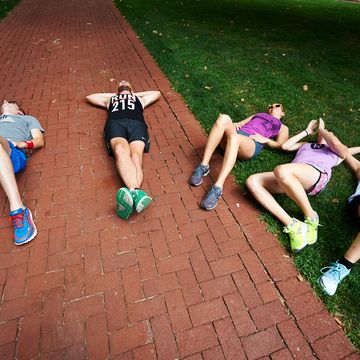Ask an endurance athlete to describe the most miserable part of training and racing, and her answer is likely to include the pre-race taper.
If you’re all too familiar with taper week and the tantrums that ensue, it’s likely that your friends and family are too. After all, it’s hard to forget a week when a typically endorphin-charged, happy, and eat-anything-I-want-and-get-away-with-it runner is moody, sullen, nervous, and no fun to be around.
Having just survived Ironman 70.3 and the taper that preceded it, and based on more than a decade of training for events (and then going through the subsequent withdrawal), here are some savvy ways to avoid being a complete jerk during times of tapering, how to eat well to fuel for your race without over doing it, and how to use some of that nervous energy to your benefit.
Stop overcompensating
It’s not unusual for endurance athletes to have diets riddled with empty calories and mindless eating (on occasion). After all, we earned it! This week is not the time to continue with that pattern. Sure, there’s a good chance you’ll gain a bit of weight later in the week thanks to fluids, electrolytes, and the carb load, but shortly after the race, that weight should fade. However, if you spend the week eating like you’re still running 50 miles a week, you might end of with more than just a medal as a souvenir. Think twice before mindless snacking on late-night chips or extra servings at every meal. While you need to carb load, it’s not an all week event nor is it a free pass to go wild on every piece of bread, cracker, croissant, cookie, or pretzel, that you encounter. (meals at home with the Runner’s World Eating Well Through the Taper Chef'd meal plan delivery service.)
Remember your nutrients
Let’s take a moment to visualize a plateful of carbs. Rice, pasta, potatoes, and bread come to mind for many of us. And what color are these items? Tan. Brown. White. Not much of a rainbow, which tells me they don’t contain a whole lot of nutrients. Certainly, many choices are rich in B-vitamins and macronutrients, but they aren’t usually chockfull of the immune-boosting phytonutrients that your body needs in the days surrounding the taxing effort you’re about to encounter. Many runners shy away from fruits and veggies before a race, thanks to a fear of fiber—and I would advise most runners against going overboard on roughage in the 48 hours prior to the start. But early in the week, when your mileage drops but your hunger and habit of eating every few hours stays high, fiber is your friend, especially if you’ve been working toward achieving a certain race weight. You can eat a lot of salad, fruits, and vegetables and find yourself full well before you surpass your reduced calorie needs for the day.
Vary your “carb” load
Speaking of staying full and meeting your nutrients needs, don’t forget that protein still plays a role in the days before a race. Sure, runners need to stock up the glycogen stores before the horn goes off, but don’t discount the value that protein can play when it comes to performance and satiety. How much pasta can you really eat, anyway? Adding in some lean chicken breast or a whey smoothie can be a nice change. And don’t forget that protein is essential in building and repairing those taxed muscles so they’re strong and ready to go on race day. After those last workout sessions, even if they’re short, add in a nutrient-rich, colorful protein, fruit, and veggie smoothie. You’ll do your immune system, fluid status, and muscles a favor.
Make a list and check it twice
You’ll have a bit more free time during taper week. Instead of spending it trying to cram in last-minute, confidence-boosting—but race-derailing—hard workouts, spend it getting ready for the big event. Clearly, you’ll have a lot on your mind and will probably be just a little bit stressed about arriving at the start fully prepared and with all of your gear. Making a list early in the week can be a godsend later, when you’re frazzled and trying to pack at the last minute. Remember to include all of the essential gear items (shoes, apparel, etc.) as well as fuel (water bottles, gel/chew/blocks), and items needed before and after the race. By making a list and checking off the items as they go into the suitcase, you’ll feel more confident that you’ve got everything you need to make your new PR a reality.









